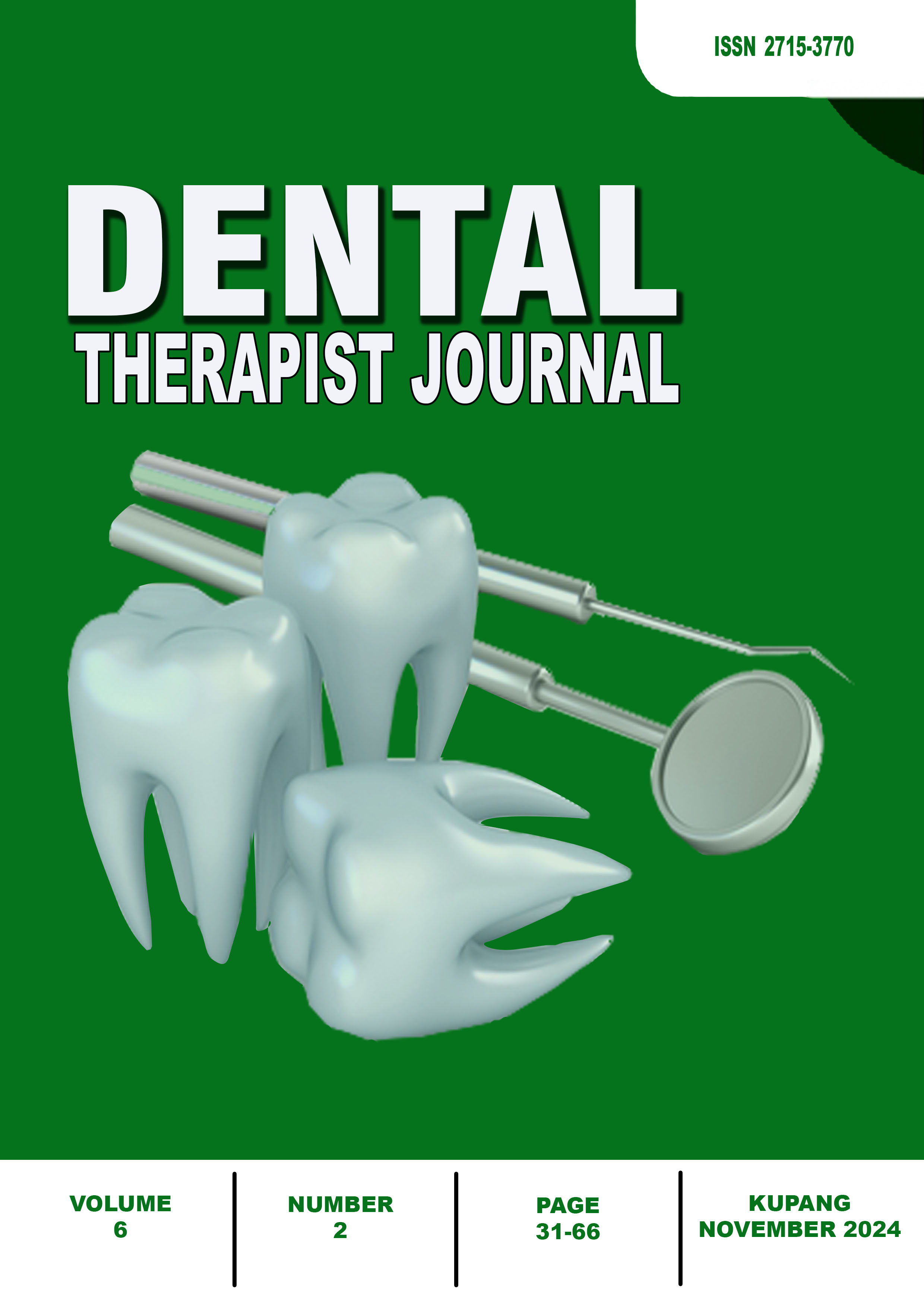The Use of Red Dragon Fruit Gel as A Disclosing Agent for Plaque Measurement
DOI:
https://doi.org/10.31965/dtj.v6i2.1695Keywords:
Gel, Disclosing, Red Dragon Fruit, Plaque IndexAbstract
Assessing oral hygiene through plaque index assessment is essential to identify areas that require attention, as poor hygiene can lead to problems such as caries, gingivitis, periodontitis and systemic health issues. In response to challenges such as limited access to natural tooth colouring materials and the side effects of chemical alternatives, red dragon fruit has emerged as a safe and natural option. This experimental study aimed to develop a red dragon fruit disclosing gel with concentrations of 35%, 50%, and 75% and to compare the staining effectiveness of these three concentrations. The study employed an experimental research design categorized as an "experimental study" using the Posttest Only Design. In this design, interventions (X) are carried out, followed by posttest measurements (O2). Since there is no control group, the results of O2 cannot be compared with other groups. This approach is also referred to as the "One-Shot Study." The observations (O2) provide descriptive data, with parameters measured including color intensity and plaque index scores. The study was conducted on university students as the sample population. The results revealed that a 35% concentration of red dragon fruit gel was effective in disclosing dental plaque by staining it. However, the highest color absorption and most intense staining were observed at the 75% concentration. The study concluded that a 35% concentration of red dragon fruit gel is sufficient for use as a disclosing agent, while the 75% concentration provides the best and most intense staining. Future research is recommended to stabilize the anthocyanin content in red dragon fruit extract by incorporating acetic acid or other stabilizing agents.
References
Bachtiar, R., Hasanuddin, N. R., Ilmianti, I., Irawati, E., & Darwis, D. A. T. (2024). Pengaruh Berkumur Dengan Larutan Kurma Ajwa (Phoenix Dactylifera L.) Terhadap Penurunan Indeks Gingiva Pada Pengguna Ortodonti Cekat. Indonesian Journal of Public Health, 2(3), 520-527. Retrieved from https://jurnal.academiacenter.org/index.php/IJOH/article/view/474
Bastendorf, K. D., Strafela-Bastendorf, N., & Lussi, A. (2021). Mechanical removal of the biofilm: is the curette still the gold standard?. Oral Biofilms, 29, 105-118. https://doi.org/10.1159/000510187
Chaurasiya, A., & Verma, N. K. (2024). Tooth Decay: A Review. Sch Acad J Pharm, 6, 271-276. https://doi.org/ 10.36347/sajp.2024.v13i06.009
Hakim, A. (2018). Perbandingan Daya Tembus Pewarna Antara Disclosing Solution (Larutan Pengungkap) Buatan Pabrik dengan Ekstrak Daging Buah Naga Merah (Hylocereus costaricensis). Skripsi. Universitas Jember. Retrieved from: https://repository.unej.ac.id/handle/123456789/87852
Ifitri, I., Faisal, M., Eriyati, E., & Doni, A. W. (2024). Frekuensi Menyikat Gigi dengan Status Karies Gigi pada Siswa SMP Negeri 1 Batipuh Kecamatan Batipuh Kabupaten Tanah Datar. Jurnal Sehat Mandiri, 19(2), 268-277. https://doi.org/10.33761/jsm.v19i2.1563
Jaffar, S., Taj, M. K., Hassani, I. T., Khan, M. A., Azam, S., Khan, S., ... & Jaffar, H. (2021). Factors Responsible for Dental Caries Among Patients and Its Management. Pak-Euro Journal of Medical and Life Sciences, 4(Special Is), S196-S209. https://doi.org/10.31580/pjmls.v4iSpecial%20Is.1711
Jakubovics, N. S., Goodman, S. D., Mashburn‐Warren, L., Stafford, G. P., & Cieplik, F. (2021). The dental plaque biofilm matrix. Periodontology 2000, 86(1), 32-56. https://doi.org/10.1111/prd.12361
Kementerian Kesehatan Republik Indonesia.(2018). Hasil Utama Riset Kesehatan Dasar (RISKESDAS) 2018. Jakarta: Kementerian Kesehatan Republik Indonesia
Kleinberg, I. (2002). A mixed-bacteria ecological approach to understanding the role of the oral bacteria in dental caries causation: an alternative to Streptococcus mutans and the specific-plaque hypothesis. Critical Reviews in Oral Biology & Medicine, 13(2), 108-125. https://doi.org/10.1177/154411130201300202
Lestari, U., Syamsurizal, S., & Trisna, Y. (2021). The Antiplaque Efficacy and Effectiveness of Activated Charcoal Toothpaste of Elaeis guineensis in Smokers. Indonesian Journal of Pharmaceutical Science and Technology, 1, 75-87. https://doi.org/10.24198/ijpst.v1i1.32664
Marsh, P. D., Head, D. A., & Devine, D. A. (2015). Dental plaque as a biofilm and a microbial community—Implications for treatment. Journal of oral biosciences, 57(4), 185-191. https://doi.org/10.1016/j.job.2015.08.002
Putri, E. D., Pratiwi, C. I., Dirgantara, D., Irzal, E., Adhani, F., Ilmi, Q., & Surya, L. S. (2024). Alternative disclosing solution from natural materials. Makassar Dental Journal, 13(3), 435-437. https://doi.org/10.35856/mdj.v13i3.892
Rowińska, I., Szyperska-Ślaska, A., Zariczny, P., Pasławski, R., Kramkowski, K., & Kowalczyk, P. (2021). The influence of diet on oxidative stress and inflammation induced by bacterial biofilms in the human oral cavity. Materials, 14(6), 1444. https://doi.org/10.3390/ma14061444
Ruiz Núñez, M. D. R., da Luz Raulino, M., Goulart Castro, R., & Schaefer Ferreira de Mello, A. L. (2022). Dental plaque control strategies for the elderly population: A scoping review. International journal of dental hygiene, 20(1), 167-181. https://doi.org/10.1111/idh.12497
Valm, A. M. (2019). The structure of dental plaque microbial communities in the transition from health to dental caries and periodontal disease. Journal of molecular biology, 431(16), 2957-2969. https://doi.org/10.1016/j.jmb.2019.05.016
Varsha, M., Kumar, P. S., & Rathi, B. S. (2022). A review on recent trends in the removal of emerging contaminants from aquatic environment using low-cost adsorbents. Chemosphere, 287, 132270. https://doi.org/10.1016/j.chemosphere.2021.132270











